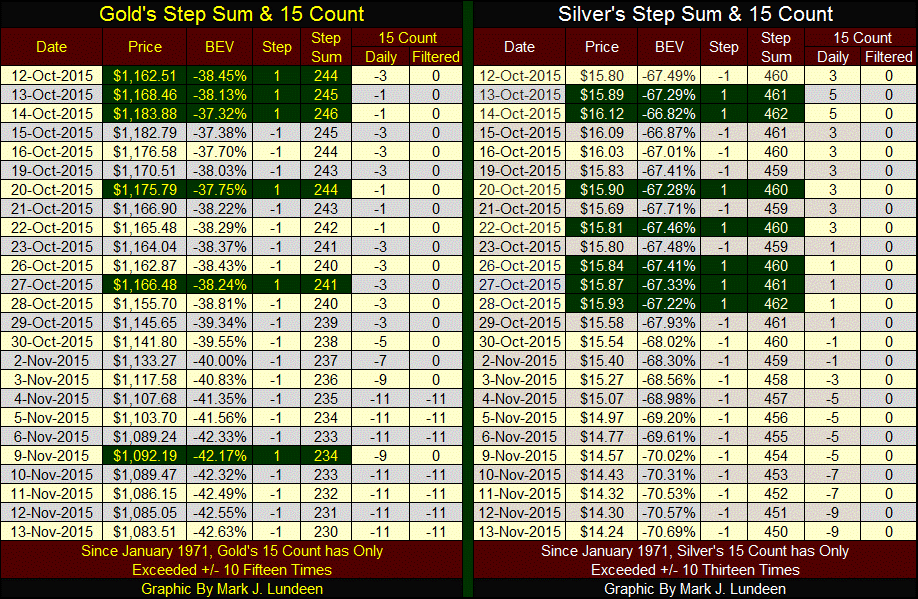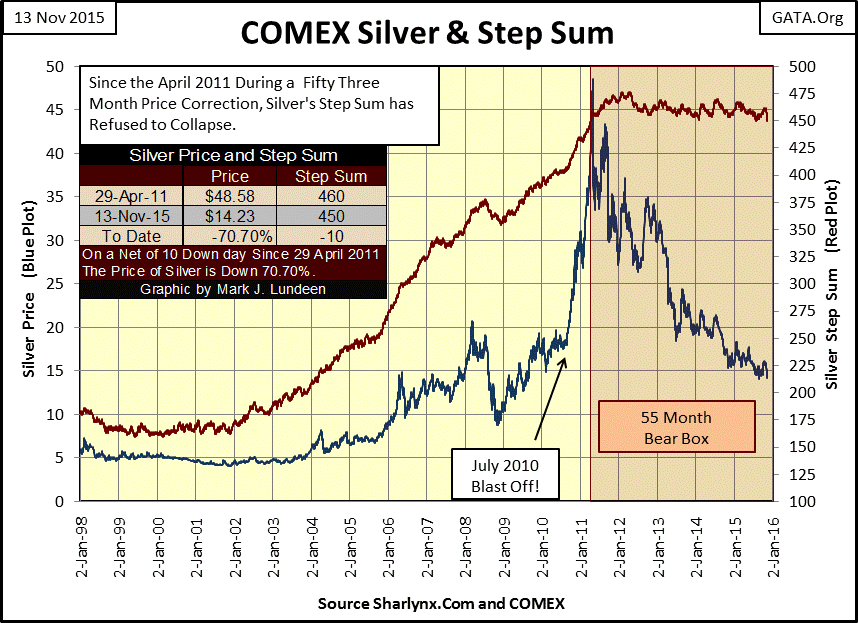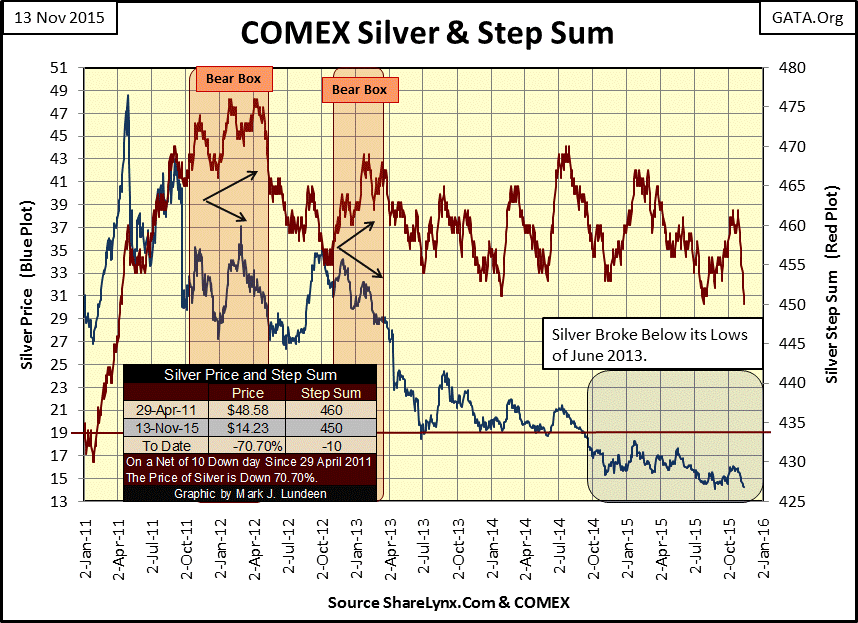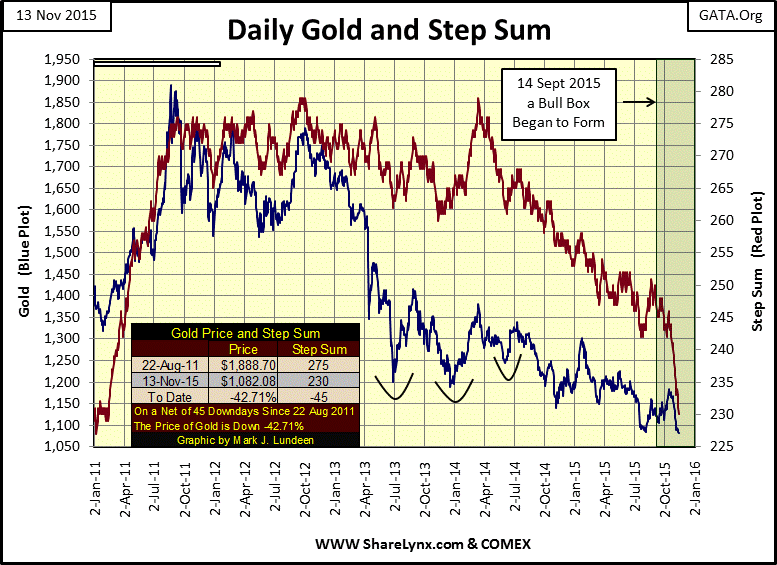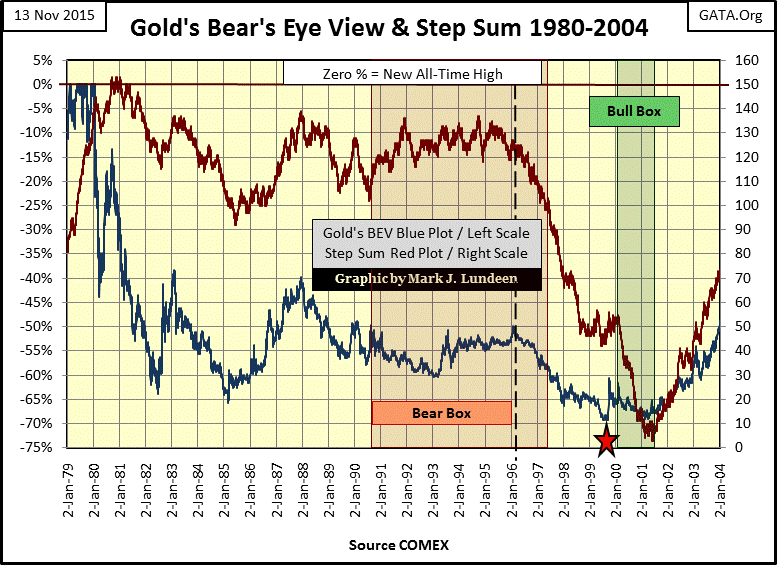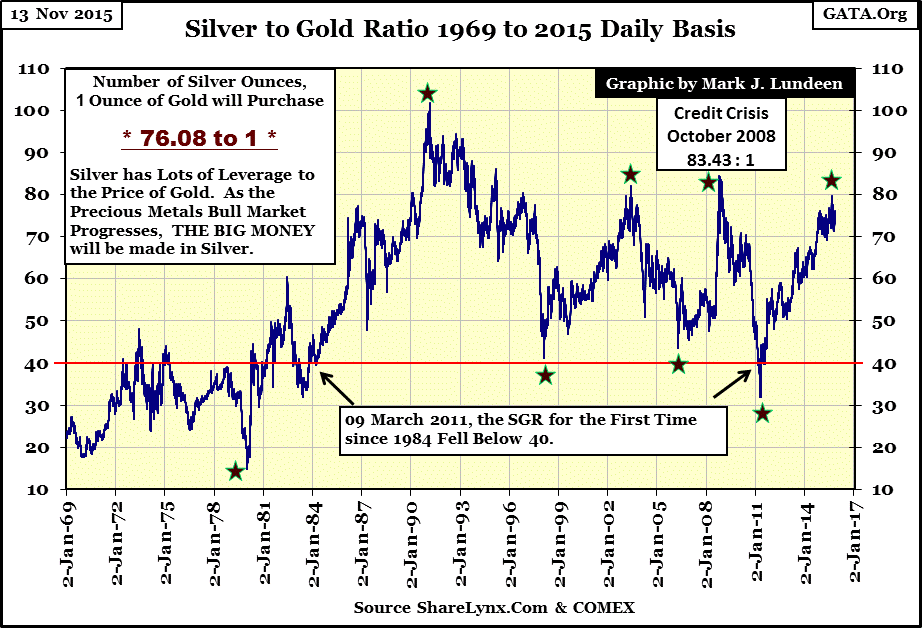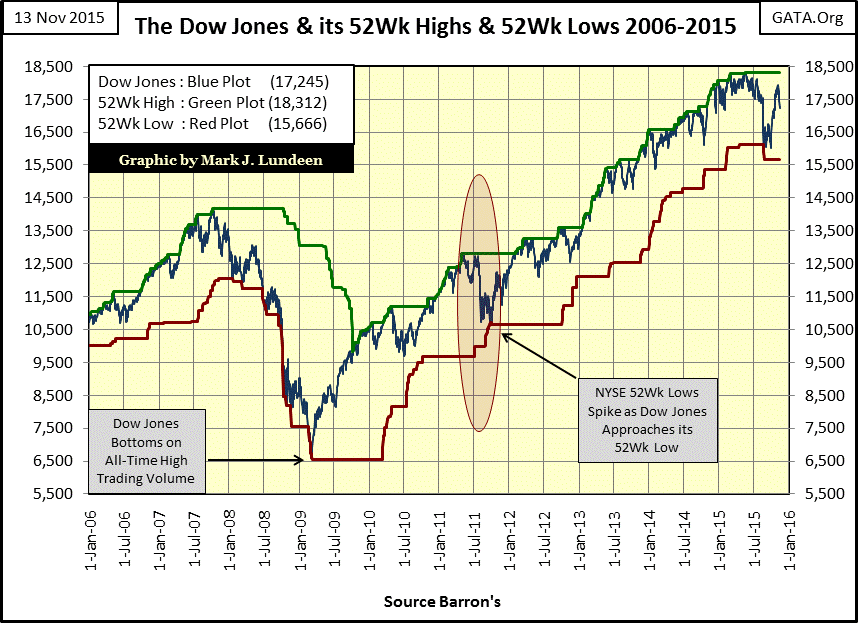Follow Up On Gold Price And Silver’s Step Sums
The silver market has joined gold in a selling panic; a panic defined as a period of overwhelming down days, but not necessarily a period of crumbling prices. As with gold, it’s the silver bears panicking, not the bulls. I’m not saying the bulls aren’t absorbing more than their fair share of abuse, or that some bulls aren’t calling it quits and tossing in the towel. I’m just noting that considering all the down days in the past few weeks, the old monetary metals are actually holding up better than I would have expected. Silver has yet to make a new bear market low; unfortunately gold closed the week at a new bear market low, but just barely.
Let’s take a quick look at gold and silver’s 15 count in the table below. I’ve highlighted the up days in green. Since October 12th we’ve seen twenty-five trading days (five weeks), during which gold has advanced only six days; silver only seven. That left gold with nineteen down days, and silver down eighteen trading days of the past twenty five.
Look at the prices and BEV data since October 12th; gold is down $79.00 (6.80%) or 5.5 BEV points, and silver has lost only $1.56 (9.83%) or 3.75 BEV points. For all the hammer blows on the price of gold and silver the bulls have endured over the past five weeks, the bears haven’t really managed to accomplish as much damage as they must have wished. Look at silver’s 15 count. Over the past month it has fallen from a +5 to a -9 with the step sums (market sentiment) for both metals now collapsing.
Is silver’s fifty-four month bear box about to close? Looking at the long-term chart below it doesn’t appear to be. How far would silver’s step sum need to decline before we say its bear box is closed? As reading price charts is more art than science there is no exact rule to follow, but a swift decline below 430 in the next two months might just do the trick. And that will just close the box; meaning that bullish-market sentiment has seen the error of its ways in the face of declining prices, the point where the step sum and price plots once again trend in the same direction, which in a bear box is down.
Typically following the closing of a step-sum bear box the price and step sum trends will continue to decline for a time. However seeing the box close is a strong indication that the worse of the market decline, in time and declining prices is over. There have been exceptions to that rule, such as the Dow Jones’ Great Depression bear box and gold’s bear box of the 1990s. However I don’t believe gold and silver’s current bear boxes will prove to be another exception to this rule.
What a miserable five years and 70% price decline for the silver bulls! All of this misery was created by the selling of nonexistent silver at the COMEX and LBMA by zombie banks which should have been liquidated in the aftermath of the 2007-09 mortgage crisis. When the market ultimately prices real silver bullion correctly (without including bogus paper silver futures contracts), the market situation will change rapidly. See what silver did from February 2010 to April 2011; it moved from $15 to $49 in little more than a year (above). Do not be surprised if we soon see a repeat performance.
This next silver chart with its step sum goes back to January 2011. In this shorter term chart I’d say a step sum decline to 440 in the next two months would close the box. This assumes that silver’s price continues on its bearish trend, which it may not.
Looking at the gold and silver markets from the view point of step-sum theory, we are observing how bear boxes ultimately end; when bullish market sentiment (as measured by a step sum) finally collapses and starts to decline along with falling prices in a bear market. That done the market can then go on to advance.
But calling market turns is a hazardous business. In the chart above we see two short term bear boxes that formed and closed years ago which weren’t at all helpful in calling the bottom in the silver market. But had the CFTC been doing its job, preventing the big banks from selling tens-of-thousands of tons of fictional silver in the futures market, I expect these boxes just may have called it.
Now on to gold and its step sum below. At the end of this week I could close gold’s bear box, but you make your own call. I think it’s fair to say gold’s price and step sum trends have recoupled in the chart below, with the step sum in the early stages of a proper collapse.
Gold’s bull box below is beginning to look the worse for wear. After all whether a box is bull or bear depends on the price trend, and in a bull box the price trend should be bullish or at least trending sideways as the step sum goes down. So, the problem isn’t the collapsing step sum, but that the gold price has recoupled with the bearish step sum. Last week I gave $1000 gold as the termination point for the bull box, the point where the box would fail, but this week I’m moving it up to $1050. Unless the price of gold takes off in the next few weeks, I’m not expecting much from this box.
However looking at this four year view of the gold market, it’s obvious the bear box that began in August 2011 is now closed as gold’s price and step sum trends have recoupled. I don’t know what the ultimate bear market low price of gold will be, or how many more weeks or months it will take to get there, but the bear market in gold is apparently now approaching its end point.
Below is one of my favorite step sum charts, the gold market from 1980 to 2004. We see a massive bear box form ten years into the bear market. In early 1996 the bear box closed as gold’s price and step sum both began their terminal bear market declines. The absolute bottom of this bear market was on 19 July 1999 (Red Star $253.70) on news the Bank of England was to sell 400 tons of its monetary gold over the next few years. The bull box began in early 2000. The price of gold declined during this box, but never broke below its lows of July 1999 as gold step sum totally collapsed. The price of gold saw a double bottom on 15 February 2001 at $255.10, a $1.40 above its July 1999 price. Its step sum bottomed at 3 four months later in June with gold then at $264.90. The bearish step sum then recoupled with gold’s bullish price trend closing the bull box, after which gold’s price and step sum plots began a ten year 640% advance, ending in August 2011.
In the chart above, (post 2001) where gold’s price and step sum plots reverse upwards is exactly how I expect the current bear boxes in gold and silver to finally resolve themselves. We just need a little more time and maybe lower metal prices to get there.
Moving on to the Silver to Gold Ratio (SGR), (the number of ounces of silver one ounce of gold can purchase), it ended the week at 76.08. The thing about this chart (below) to note is the fluidity in the ratio. Since 1969 it’s either going up or down, seldom staying at one place for long. However as with so many other historical standards since the credit crisis, the SGR has been range bound between 70 and 80 for the past fourteen months.
It made an attempt to break above the 80 line in August (79.71), but failed. That’s a good sign for us bulls, as historically we make money in the precious metals when the SGR is declining. Well if it won’t go up, hopefully the next big move will be to the down side, marking the resumption of the bull market in gold and silver.
It goes without saying that the bull market in gold and silver that began in 2001 hasn’t yet resumed, but it’s still impressive how firm the price of gold and silver have been despite the daily assaults on their price that began in mid-October.
Compare their performance over the past five weeks with the Dow Jones this week. Last Friday the Dow Jones closed just ninety points away from 18,000, and only 402 points away from its all-time high of last May. Here’s some good news / bad news for the stock-market bulls; the good news is that from last Friday’s close the Dow Jones moved 665 points. The bad news is that it closed 665 points below last Friday’s price.
Here’s the problem for the bulls as I see it: in bull markets rising prices create more buying, causing the market to advance. But after a market’s Terminal Zero (last all-time high of a bull market) any market advance toward its all-time high price actually create selling pressure as the smart money exits the market (see below). I could be wrong, but the burden of proof is on the bulls in the FOMC.
Looking at the Dow Jones BEV chart above, if in the next few weeks it declines below its 7.50% line, the likelihood of the current advance failing is very high. And should it decline below its lows of last August, it would be very bad technically. However, breaking below these two thresholds would just be bear signs in the current bull market. To know if Mr Bear has actually returned we’d need to see a resumption in days of Extreme Volatility and Market Breadth and have the Dow Jones break below its current 52Wk Low of 15,666 (chart below).
How likely is all that to happen? I couldn’t really say, but on November 10th ZeroHedge posted a very interesting article on a recent report by the Federal Reserve on the condition of the American banking system.
“Late last week, a consortium of financial regulators in the United States, including the Federal Reserve and the FDIC, issued an astonishing condemnation of the US banking system.
Most notably, they highlighted ‘continuing gaps between industry practices and the expectations for safe and sound banking.’”
http://www.zerohedge.com/news/2015-11-10/us-banks-are-not-sound-fed-report-finds
That sounds ominous. One would think that if the banking system’s “regulators” were actually doing their jobs the banking system would never find itself in a situation where “continuing gaps between industry practices and the expectations for safe and sound banking” could occur. But for the second time in a decade here we stand.
If we learned anything from the Credit Crisis it’s that you can’t have a bull market in stocks and bonds when the banking system ceases to function because of multi-trillion dollar counterparty failures and chronic insolvency.
Publishing note: As we are entering the holiday season I’m going to take some time off. This is my last article for November, and I plan to publish articles for only the first two weeks of December. I’ll begin my regular articles beginning on Friday January 8th. But I’ll be following the markets all through the holidays, and if something happens that inspires me to write, I’ll send something your way.
Mark J. Lundeen






